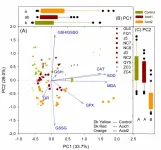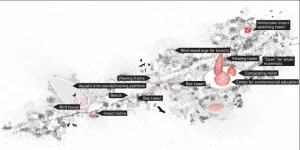(Press-News.org) NEW YORK, January 12, 2024 — Proteins do the heavy lifting of performing biochemical functions in our bodies by binding to metabolites or other proteins to complete tasks. To do this successfully, protein molecules often shape-shift to allow specific binding interactions that are needed to perform complex, precise chemical processes.
A better understanding of the shapes proteins take on would give researchers important insight into stopping or treating diseases, but current methods for revealing these dynamic, three-dimensional forms offer scientists limited information. To address this knowledge gap, a team from the Advanced Science Research Center at the CUNY Graduate Center (CUNY ASRC) designed an experiment to test whether performing X-ray crystallography imaging using elevated temperature versus elevated pressure would reveal distinct shapes. The results of the team’s work appear in the journal Communications Biology.
“Protein structures don’t sit still; they shift between several similar shapes much like a dancer,” said the study’s principal investigator Daniel Keedy, Ph.D., a professor with the CUNY ASRC’s Structural Biology Initiative and a chemistry and biochemistry professor at The City College of New York and the CUNY Graduate Center. “Unfortunately, existing approaches for viewing proteins only reveal one shape, or suggest the presence of multiple shapes without providing specific details. We wanted to see if different ways of poking at a protein could give a us a more detailed view of how it shape-shifts.”
For their experiment, the team obtained crystals of STEP, also known as PTPN5—a drug target protein for the treatment of several diseases, including Alzheimer’s—and agitated them using either high pressure (2,000 times the Earth’s atmospheric pressure) or high temperature (body temperature), both of which are very different from typical crystallography experiments at atmospheric pressure and cryogenic temperature (-280 F, -173 C). The researchers viewed the samples using X-ray crystallography and observed that high temperature and high pressure had different effects on the protein, revealing distinct shapes.
While high pressure isn’t a condition that proteins experience inside the body, Keedy said the agitation method exposed different structural states of the protein that may be relevant to its activity in human cells.
“Having the ability to use perturbations such as heat and pressure to elucidate these different states could give drug developers tools for determining how they can trap a protein in a particular shape using a small-molecule drug to diminish its function,” Keedy added.
About the Advanced Science Research Center at the CUNY Graduate Center
The Advanced Science Research Center at the CUNY Graduate Center (CUNY ASRC) is a world-leading center of scientific excellence that elevates STEM inquiry and education at CUNY and beyond. The CUNY ASRC’s research initiatives span five distinctive, but broadly interconnected disciplines: nanoscience, photonics, neuroscience, structural biology, and environmental sciences. The center promotes a collaborative, interdisciplinary research culture where renowned and emerging scientists advance their discoveries using state-of-the-art equipment and cutting-edge core facilities.
END
Spying on a shape-shifting protein
New crystallography experiments using high pressure and heat to reveal how proteins change shape could advance the development of novel drugs.
2024-01-12
ELSE PRESS RELEASES FROM THIS DATE:
Researchers sequence the first genome of myxini, the only vertebrate lineage that had no reference genome
2024-01-12
An international scientific team made up of more than 40 authors from seven different countries, led by the researcher at the University of Malaga Juan Pascual Anaya, has managed to sequence the first genome of the myxini –also known as ‘hagfish’–, the only large group of vertebrates for which there was no reference genome of any of its species yet.
This finding, published in the scientific journal ‘Nature Ecology & Evolution’, has allowed deciphering the evolutionary history of genome duplications –number of times a ...
Researchers uncover blood flow regulation of brain pericyte development
2024-01-12
In a study published online in Cell Reports, DU Jiulin’s group at the Institute of Neuroscience, Center for Excellence in Brain Science and Intelligence Technology of the Chinese Academy of Sciences, and the collaborators, created a zebrafish model for in vivo labeling of brain pericytes and systematically explored the developmental dynamics of brain pericytes during the early embryonic stage. The researchers revealed the promoting effect of blood flow on the proliferation of pericytes after ingress into the brain and showed that this process ...
Divergent responses of growth rate and antioxidative system of ten Bacillus strains to acid stresses
2024-01-12
Soil aciditification is widely occurring in diverse terrestrial ecosystems and soil microbial communities have been reported to be highly sensitive to changes in soil pH. Soil microbes could regulate their physiological conditions to make them survive under the aciditifying conditions. This study demonstrates that ten Bacillus strains are able to regulate the antioxidative system differently in response to the decreasing environmental pH condition, and therefore have different acid tolerance capacity. The researchers’ ...
HKUST researchers develop a versatile, reconfigurable, and damage-tolerant single-wire sensor array
2024-01-12
Researchers from The Hong Kong University of Science and Technology (HKUST) have developed a sensor array design technology inspired by the human auditory system. By mimicking the human ear's ability to distinguish sounds through tonotopy, this innovative sensor array approach could optimize the application of sensor arrays in fields such as robotics, aviation, healthcare, and industrial machinery.
Traditional sensor arrays face challenges such as complex wiring, limited reconfigurability, and low damage resistance. The design developed by the HKUST team, led by Associate Professor YANG Zhengbao from the Department of Mechanical & Aerospace ...
Between building and unbuilding: An interdisciplinary design approach to cohabitation, material cycles, and traditional ecological knowledge
2024-01-12
In recent history, built environment practices have accepted a paradigm which underlines the land’s static quality, prioritizes immediate utility, and consequently adopts design processes that inevitably accelerate assimilation. With the capitalist propensity to obtain control and enhance efficiency, those processes nevertheless privilege certain cultures while rejecting other forms of knowledge or living specific to the land. The design discourse, confronted with the rising pressure of global climate challenges and environmental inequity, suggests a ...
Team explores role of STING – stimulator of interferon genes – in body’s innate immune system
2024-01-12
When pathogens attack the body, the innate immune system goes to work protecting against the invading disease. The innate immune system is the first line of defense. It detects precisely what the virus or bacteria is and then activates the proteins that fight the pathogens. Wanting to better understand how the body’s innate immune system works, a team of scientists undertook a study of STING, a protein that plays a vital role in innate immunity.
The team provides quantitative results, showing how STING, an acronym for stimulator of interferon genes, works in innate immune signaling.
Their work is published in the journal Nature Communications on Jan ...
New Antarctic research shows that Adélie penguins must balance the benefits and costs of riding on sea ice during their long-distance migration
2024-01-12
Petaluma, CA--Newly published research by Petaluma-based non-profit, Point Blue Conservation Science, shows how Adélie penguins within the Ross Sea, Antarctica use sea ice in their annual migrations. The results were published in the journal Ecology, a publication of the Ecological Society of America.
Adélie penguins, though flightless, can undertake extraordinary migrations like their flying relatives, traveling thousands of kilometers out to sea from their on-land breeding colonies in Antarctica, tracking daylight and food during the long Antarctic winter. Many other species are known to use wind ...
Antibiotic use is not the only driver of superbugs
2024-01-12
For the first time, researchers have analysed the impact of antibiotic use on the rise of treatment-resistant bacteria over the last 20 years in the UK and Norway. They show that while the increase in drug use has amplified the spread of superbugs, it is not the only driver.
Researchers from the Wellcome Sanger Institute, the University of Oslo, the University of Cambridge, and collaborators, conducted a high-resolution genetic comparison of bacteria. They compared over 700 new blood samples with nearly 5,000 ...
Two common biomarkers predict heart risk in asymptomatic childhood cancer survivors
2024-01-12
(MEMPHIS, Tenn. – January 11, 2024) Data from the St. Jude lifetime cohort study (St. Jude LIFE) revealed that two common biomarkers of cardiac function and damage could better predict cardiomyopathy within five years than routine clinical evaluations in high-risk, asymptomatic childhood cancer survivors. Early detection through screening using these two biomarkers may lead to earlier treatment to prevent and protect against further heart damage. The findings were published today in the Journal of Clinical Oncology.
Cardiomyopathy is often asymptomatic at onset and thus “invisible” to routine clinical evaluations. St. Jude ...
More than skin deep: A molecular look at the mechanisms behind pigmentation variation
2024-01-12
Researchers from the University of Pennsylvania have discovered key insights into the molecular basis of skin color variations among African populations. Their findings, published in Nature Genetics, broaden the understanding of human evolution and the genetics underpinning contemporary human skin color diversity.
“Despite the abundant genetic diversity within African populations, they have been historically underrepresented in genetic studies,” says senior author Sarah Tishkoff, a Penn Integrates ...
LAST 30 PRESS RELEASES:
Survey reveals ethical gaps slowing AI adoption in pediatric surgery
Stimulant ADHD medications work differently than thought
AI overestimates how smart people are, according to HSE economists
HSE researchers create genome-wide map of quadruplexes
Scientists boost cell "powerhouses" to burn more calories
Automatic label checking: The missing step in making reliable medical AI
Low daily alcohol intake linked to 50% heightened mouth cancer risk in India
American Meteorological Society announces Rick Spinrad as 2026 President-Elect
Biomass-based carbon capture spotlighted in newly released global climate webinar recording
Illuminating invisible nano pollutants: advanced bioimaging tracks the full journey of emerging nanoscale contaminants in living systems
How does age affect recovery from spinal cord injury?
Novel AI tool offers prognosis for patients with head and neck cancer
Fathers’ microplastic exposure tied to their children’s metabolic problems
Research validates laboratory model for studying high-grade serous ovarian cancer
SIR 2026 delivers transformative breakthroughs in minimally invasive medicine to improve patient care
Stem Cell Reports most downloaded papers of 2025 highlight the breadth and impact of stem cell research
Oxford-led study estimates NHS spends around 3% of its primary and secondary care budget on the health impacts of heat and cold in England
A researcher’s long quest leads to a smart composite breakthrough
Urban wild bees act as “microbial sensors” of city health.
New study finds where you live affects recovery after a hip fracture
Forecasting the impact of fully automated vehicle adoption on US road traffic injuries
Alcohol-related hospitalizations from 2016 to 2022
Semaglutide and hospitalizations in patients with obesity and established cardiovascular disease
Researchers ‘listen in’ to embryo-mother interactions during implantation using a culture system replicating the womb lining
How changing your diet could help save the world
How to make AI truly scalable and reliable for real-time traffic assignment?
Beyond fragmented markets: A new framework for efficient and stable ride-pooling
Can shape priors make road perception more reliable for autonomous driving?
AI tracks nearly 100 years of aging research, revealing key trends and gaps
Innovative techniques enable Italy’s first imaging of individual trapped atoms
[Press-News.org] Spying on a shape-shifting proteinNew crystallography experiments using high pressure and heat to reveal how proteins change shape could advance the development of novel drugs.










